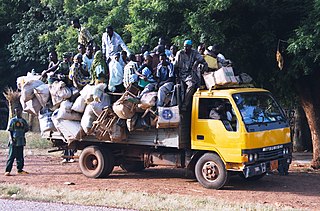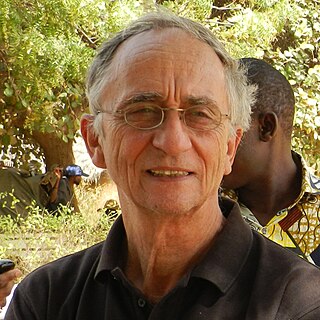Related Research Articles

The music of Niger has developed from the musical traditions of a mix of ethnic groups; Hausa, the Zarma-Songhai, Tuareg, Fula, Kanuri, Toubou, Diffa Arabs and Gurma and the Boudouma from Lac Chad.

Jean Rouch was a French filmmaker and anthropologist.

The Songhay, Songhai or Ayneha languages are a group of closely related languages/dialects centred on the middle stretches of the Niger River in the West African countries of Mali, Niger, Benin, Burkina Faso and Nigeria. In particular, they are spoken in the cities of Timbuktu, Djenné, Niamey, Gao, Tillaberi, Dosso, Parakou, Kandi, Natitingou, Djougou, Malanville, Gorom-Gorom, In-Gall and Tabelbala. They have been widely used as a lingua franca in that region ever since the era of the Songhai Empire. In Mali, the government has officially adopted the dialect of Gao as the dialect to be used as a medium of primary education.

Zarma is one of the Songhay languages. It is the leading indigenous language of the southwestern lobe of the West African nation of Niger, where the Niger River flows and the capital city, Niamey, is located. Zarma is the second-most common language in the country, after Hausa, which is spoken in south-central Niger. With over 6 million speakers, Zarma is easily the most widely spoken Songhay language.

The culture of Niger is marked by variation, evidence of the cultural crossroads which French colonialism formed into a unified state from the beginning of the 20th century. What is now Niger was created from four distinct cultural areas in the pre-colonial era: the Djerma dominated Niger River valley in the southwest; the northern periphery of Hausaland, made mostly of those states which had resisted the Sokoto Caliphate, and ranged along the long southern border with Nigeria; the Lake Chad basin and Kaouar in the far east, populated by Kanuri farmers and Toubou pastoralists who had once been part of the Kanem-Bornu Empire; and the Tuareg nomads of the Aïr Mountains and Saharan desert in the vast north. Each of these communities, along with smaller ethnic groups like the pastoral Wodaabe Fula, brought their own cultural traditions to the new state of Niger.

The Songhai people are an ethnolinguistic group in West Africa who speak the various Songhai languages. Their history and lingua franca is linked to the Songhai Empire which dominated the western Sahel in the 15th and 16th century. Predominantly adherents of Islam, the Songhai are primarily located in Niger and Mali. Historically, the term "Songhai" did not denote an ethnic or linguistic identity but referred to the ruling caste of the Songhay Empire known as the Songhaiborai. However, the correct term used to refer to this group of people collectively by the natives is "Ayneha". Although some speakers in Mali have also adopted the name Songhay as an ethnic designation, other Songhay-speaking groups identify themselves by other ethnic terms such as Zarma or Isawaghen. The dialect of Koyraboro Senni spoken in Gao is unintelligible to speakers of the Zarma dialect of Niger, according to at least one report. The Songhay languages are commonly taken to be Nilo-Saharan but this classification remains controversial: Dimmendaal (2008) believes that for now it is best considered an independent language family.

The Zarma people are an ethnic group predominantly found in westernmost Niger. They are also found in significant numbers in the adjacent areas of Nigeria and Benin, along with smaller numbers in Burkina Faso, Ivory Coast, Ghana, Togo, and Sudan. In Niger, the Zarma are often considered by outsiders to be of the same ethnicity as the neighboring Songhaiborai, although the two groups claim differences, having different histories and speaking different dialects. They are sometimes lumped together as the Zarma-Songhay or Songhay-Zarma.
The Arma people are an ethnic group of the middle Niger River valley, descended from Moroccan invaders of the 16th century. The name, applied by other groups, derives from the word ar-rumah "fusiliers".

Téra is a department of the Tillabéri Region in Niger. Its capital is the city of Téra. As of 2011, the department had a total population of 579,658 people.

Seasonal migration, locally called the Exode, plays an important part of the economic and cultural life of the West African nation of Niger. While it is a common practice in many nations, Niger sees as much as a third of its rural population travel for seasonal labour, during the Sahelian nation's long dry season. Common patterns of seasonal travel have been built up over hundreds of years, and destinations and work vary by community and ethnic group.
Damouré Zika was a Nigerien traditional healer, broadcaster, and film actor. Coming from a long line of traditional healers in the Sorko ethnic group of western Niger, Zika appeared in many of the films of French director Jean Rouch, becoming one of Niger's first actors. As a practitioner of traditional medicine, he opened a clinic in Niamey, and was for many years a broadcaster and commentator on health issues for Niger's national radio.
Tondikandia is a rural commune in Filingué Department, Tillabéri Region, Niger. Its chief place and administrative center is the town of Damana.
The Dawsahak people, Idaksahak are pastoralist Berbers centered on Ménaka and Inékar town in Ménaka Region and Talataye in Ansongo Cercle of the Gao Region of northeastern Mali. They speak the Northern Songhai language Tadaksahak. Many also speak Western Tawallammat Tamajaq language, the Tuareg language of southern Gao. Daoussahak appears to be the most common transliteration of the collective name among French and English academics.

Songhoyboro Ciine or Songhay Ciiné is an upriver dialect of the southern Songhay dialect of Niger. It is spoken mostly in the northwestern corner of Niger's Tillaberi region, an area known as Songhay: from Gorouol, a border town with Mali, down to the towns of Tera, Anzourou, Namari Goungou and Say.
Southern Songhay is the more populous branch of the Songhay languages, centered on the Niger River, including Timbuktu and the old capital of Gao. It includes Zarma (Djerma), a major language of Niger.

Jean-Pierre Olivier de Sardan is a French and Nigerien anthropologist, and Emeritus Professor of Anthropology at the École des Hautes Études en Sciences Sociales in Marseilles. He is also Emeritus Director of Research at the Centre National de la Recherche Scientifique in Paris and associate professor at Abdou Moumouni University in Niamey where he founded the master of socio-anthropology of health.

The Songhai, ) is an area in the northwestern corner of Niger's Tillabéri Region populated mainly by the Songhaiborai. It is considered the heartland of the Songhai people and the sanctuary of their ancient pantheon and priestly class and the place in which the original lineage of the Sonni dynasty retreated after the coup d'etat of 1493 creating a secret society of magicians, the Sohance.
The Wogo people are a small subgroup of the broader Songhai people. They are found primarily in Niger and Mali on the banks and islands of the Niger river, a territory they share with the Zarma, the Kurtey and the Songhay. The main Wogo communities are found on the islands in the Tillabery region of Niger with the largest being Ayorou in Niger and Boura in Mali. They speak the Wogo Ciine songhay dialect.

The Songhaiborai are a distinct subgroup within the larger Songhai ethnolinguistic family. Residing predominantly in Niger's Songhai region, Northern Mali, and a minority presence in Burkina Faso. Notably, they trace their lineage to the ruling dynasties of the ancient Songhai Empire.
The Sohance are a social caste among the Songhai nobility. They are believed to be the direct descendants of the Sonni Dynasty and its last ruler, Sonni Ali Ber, the founder of the Songhai Empire, who reigned from 1464 to 1492.
References
- 1 2 3 Decalo, Samuel (1997). Historical Dictionary of the Niger (3rd ed.). Boston & Folkestone: Scarecrow Press. ISBN 0-8108-3136-8.: pp. 191–192
- 1 2 Harrison, Byron, Annette Harrison, and Michael J. Rueck, with Mahaman Soumana as Interpreter. "Southern Songhay Speech Varieties in Niger: A Sociolinguistic Survey of the Zarma, Songhay, Kurtey, Wogo, and Dendi Peoples of Niger." (1997).
- ↑ Minority Rights Group International, World Directory of Minorities and Indigenous Peoples - Niger : Overview, July 2008. Online. UNHCR Refworld, [accessed 8 April 2009]
- ↑ Paul Stoller. pp.94-5 in Eye, Mind and Word in Anthropology. L'Homme (1984) Volume 24 Issue 3-4 pp.91-114.
- ↑ Paul Stoller and Cheryl Olkes. In sorcery's shadow : a memoir of apprenticeship among the Songhay of Niger. Chicago : University of Chicago Press, (1987). ISBN 0-226-77542-9 p.56
- ↑ Niger: Legal Ban On Female Circumcision Widely Ignored Archived 2021-12-28 at the Wayback Machine . UN Integrated Regional Information Networks, 6 February 2004. According to this UN report, these groups are the Fula (French : Peul or Peulh; Fula : Fulɓe), Gourmantche, Djerma-Songhai, Kurtey, Wogo people and Arabs.
- ↑ Jean-Pierre Olivier de Sardan. Remarques sur la notion de «captif» (à propos des Wogo et Kurtey du Niger). Journal de la Société des Africanistes. (1970) Volume 40, Issue 40-2, pp. 171-174
- ↑ Jean Pierre Olivier de Sardan. Les voleurs d’hommes (notes sur l’histoire des Kurtey). Etudes Nigériennes no. 25. IFAN-CNRSH: Paris-Niamey (1969)
- Paul Stoller. The Negotiation of Songhay Space: Phenomenology in the Heart of Darkness. American Ethnologist, Vol. 7, No. 3 (Aug., 1980), pp. 419–431
- Jibrin Ibrahim. Political Exclusion, Democratization and Dynamics of Ethnicity in Niger. Africa Today, Vol. 41, No. 3, Electoral Successes: Harbingers of Hope? (3rd Qtr., 1994), pp. 15–39